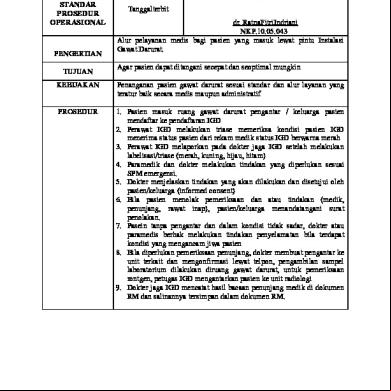Effects Of Dapagliflozin, An Sglt2 6o1w33
This document was ed by and they confirmed that they have the permission to share it. If you are author or own the copyright of this book, please report to us by using this report form. Report 2z6p3t
Overview 5o1f4z
& View Effects Of Dapagliflozin, An Sglt2 as PDF for free.
More details 6z3438
- Words: 699
- Pages: 20
Effects of Dapagliflozin, an SGLT2 Inhibitor, on HbA1c, Body Weight, and Hypoglycemia Risk in Patients With Type 2 Diabetes Inadequately Controlled on Pioglitazone Monotherapy
Annis Rakhmawati Pembimbing: dr R. Bowo Pramono, SpPDKEMD
Identitas Jurnal • Judul : Effects of Dapagliflozin, an SGLT2 Inhibitor, on HbA1c, Body Weight, and Hypoglycemia Risk in Patients With Type 2 Diabetes Inadequately Controlled on Pioglitazone Monotherapy • Penulis : Julio rosenstock et al • Publikasi 2012
: Diabetes care, volume 35, july
INTRODUCTION • SGLT2 inhibitor ↓ hiperglycemia ↓ induce mild osmotic diuresis and ↑ urinary excretion of glucose caloric elimination weight loss • Dapagliflozin, an SGLT2 inhibitor, improved glycemic control in T2DM as monotherapy & in combination with metformin, SU, or insulin, but not yet with a thiazolidinedione (TZD)
• Pioglitazone lowers glucose by enhancing insulin sensitivity. • Safety concerns of fluid retention, weight gain, CHF, bone fractures, bladder cancer has limited its use as second line therapy when metformin is not tolerated or as triple oral therapy
• Dapagliflozin glucosuria diuresis & caloric loss concern of weight gain & fluid retention/edema. • The aim to examine the safety and efficacy of dapagliflozin as SGLT2 inhibitor, added on to pioglitazone in T2DM inadequately controlled on pioglitazone.
Subjects • Inclusion Criteria – ≥ 18 y.o with fasting C-peptide ≥ 1.0 ng/mL and BMI ≤ 45.0 – 29 July 2008 and 4 July 2009. The study tookplace at 105 sites in Argentina, Canada,India, Mexico, Peru, Philippines, Taiwan,and US
• Exclusion Criteria: – – – – – –
aspartate or alanine aminotransferase ↑ 2.5 times total bilirubin 2.0 mg/dL, Cr ≥ 2.0mg/dL urine albumin/creatinine ratio 1,800 mg/g, creatinine clearance 50 mL/min, CHF cf III and IV
Methods • randomized, double blind, placebocontrolled, parallel group to examine the safety & efficacy of dapagliflozin added on to pioglitazone in T2DM inadequately controlled on pioglitazone
• Treatment-naive patients or those receiving metformin, SU, or TZD entered a 10-week pioglitazone dose-optimization period with only pioglitazone. • They were randomized, along with patients previously receiving pioglitazone ≥ 30 mg, to 48 weeks of double-blind dapagliflozin 5mg (n = 141) or 10mg (n = 140) or placebo (n = 139) every day plus openlabel pioglitazone.
• Primary end point changes from baseline in HbA1c, FPG, PPG, body weight at week 24 using ANCOVA model
Result
Discussion • In this study, the addition of dapagliflozin to pioglitazone lowered HbA1c and weight gain in T2DM inadequately controlled on pioglitazone alone. • Dapagliflozin acts in the kidney by inhibiting the reabsorption of glucose ↓ FPG , ↓ PPG
• The glucosuria induced by SGLT-2 inhibition suspected leading to hypoglycemia, UTIs, and genital infections. • Hypoglycemia events were rare in this study.
• Consistent with previous reports genital infections were higher in patients on dapagliflozin than on placebo. • None of these genital infections were serious, and all responded to antimicrobial treatment. • Dapagliflozin, acting as a mild diuretic, mitigate the fluid retaining effects of pioglitazone
Conclusion • The direct removal of glucose by dapagliflozin complements the insulin-sensitizing action of pioglitazone
Critical Appraisal Are the results Valid 1. Was the assignment of patients to treatments randomized? And was the randomization list concealed? yes 2. Was follow-up of patients sufficiently long and complete? yes 3. Were patients analyzed in the groups which they were randomized? yes 4. Were patients and clinicians kept “blind” to treatment? yes 5. Were the groups treated equally, apart from the experimental treatment? yes 6. Were the groups similar at the start of the trial? yes
Are the valid results of this randomized study important? 1. What is the magnitude of the treatment effect? No data 2. How precise is this estimate of the treatment effect? No data
Are these valid, important results applicable to our patient?
1. Is our patient so different from those in the study that its results cannot apply? No 2. Is the treatment feasible in our setting? Yes 3. What are our patient’s potential benefits and harms form the therapy? • Benefit: potential combination that balances well the benefits and risks of therapy for T2DM. • Harm : Has not been proved as gold standard therapy
Thank you
Annis Rakhmawati Pembimbing: dr R. Bowo Pramono, SpPDKEMD
Identitas Jurnal • Judul : Effects of Dapagliflozin, an SGLT2 Inhibitor, on HbA1c, Body Weight, and Hypoglycemia Risk in Patients With Type 2 Diabetes Inadequately Controlled on Pioglitazone Monotherapy • Penulis : Julio rosenstock et al • Publikasi 2012
: Diabetes care, volume 35, july
INTRODUCTION • SGLT2 inhibitor ↓ hiperglycemia ↓ induce mild osmotic diuresis and ↑ urinary excretion of glucose caloric elimination weight loss • Dapagliflozin, an SGLT2 inhibitor, improved glycemic control in T2DM as monotherapy & in combination with metformin, SU, or insulin, but not yet with a thiazolidinedione (TZD)
• Pioglitazone lowers glucose by enhancing insulin sensitivity. • Safety concerns of fluid retention, weight gain, CHF, bone fractures, bladder cancer has limited its use as second line therapy when metformin is not tolerated or as triple oral therapy
• Dapagliflozin glucosuria diuresis & caloric loss concern of weight gain & fluid retention/edema. • The aim to examine the safety and efficacy of dapagliflozin as SGLT2 inhibitor, added on to pioglitazone in T2DM inadequately controlled on pioglitazone.
Subjects • Inclusion Criteria – ≥ 18 y.o with fasting C-peptide ≥ 1.0 ng/mL and BMI ≤ 45.0 – 29 July 2008 and 4 July 2009. The study tookplace at 105 sites in Argentina, Canada,India, Mexico, Peru, Philippines, Taiwan,and US
• Exclusion Criteria: – – – – – –
aspartate or alanine aminotransferase ↑ 2.5 times total bilirubin 2.0 mg/dL, Cr ≥ 2.0mg/dL urine albumin/creatinine ratio 1,800 mg/g, creatinine clearance 50 mL/min, CHF cf III and IV
Methods • randomized, double blind, placebocontrolled, parallel group to examine the safety & efficacy of dapagliflozin added on to pioglitazone in T2DM inadequately controlled on pioglitazone
• Treatment-naive patients or those receiving metformin, SU, or TZD entered a 10-week pioglitazone dose-optimization period with only pioglitazone. • They were randomized, along with patients previously receiving pioglitazone ≥ 30 mg, to 48 weeks of double-blind dapagliflozin 5mg (n = 141) or 10mg (n = 140) or placebo (n = 139) every day plus openlabel pioglitazone.
• Primary end point changes from baseline in HbA1c, FPG, PPG, body weight at week 24 using ANCOVA model
Result
Discussion • In this study, the addition of dapagliflozin to pioglitazone lowered HbA1c and weight gain in T2DM inadequately controlled on pioglitazone alone. • Dapagliflozin acts in the kidney by inhibiting the reabsorption of glucose ↓ FPG , ↓ PPG
• The glucosuria induced by SGLT-2 inhibition suspected leading to hypoglycemia, UTIs, and genital infections. • Hypoglycemia events were rare in this study.
• Consistent with previous reports genital infections were higher in patients on dapagliflozin than on placebo. • None of these genital infections were serious, and all responded to antimicrobial treatment. • Dapagliflozin, acting as a mild diuretic, mitigate the fluid retaining effects of pioglitazone
Conclusion • The direct removal of glucose by dapagliflozin complements the insulin-sensitizing action of pioglitazone
Critical Appraisal Are the results Valid 1. Was the assignment of patients to treatments randomized? And was the randomization list concealed? yes 2. Was follow-up of patients sufficiently long and complete? yes 3. Were patients analyzed in the groups which they were randomized? yes 4. Were patients and clinicians kept “blind” to treatment? yes 5. Were the groups treated equally, apart from the experimental treatment? yes 6. Were the groups similar at the start of the trial? yes
Are the valid results of this randomized study important? 1. What is the magnitude of the treatment effect? No data 2. How precise is this estimate of the treatment effect? No data
Are these valid, important results applicable to our patient?
1. Is our patient so different from those in the study that its results cannot apply? No 2. Is the treatment feasible in our setting? Yes 3. What are our patient’s potential benefits and harms form the therapy? • Benefit: potential combination that balances well the benefits and risks of therapy for T2DM. • Harm : Has not been proved as gold standard therapy
Thank you










